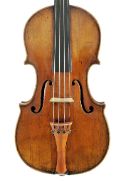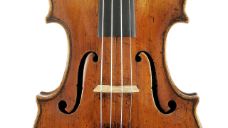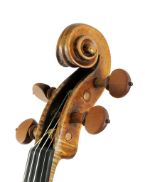Violin, Giovanni Battista Guadagnini, Turin, 1770–1775, “ex Meinel”
Printed label: “Joannes Baptista Guadagnini / Cremonensis fecit Taurini / alumnus Antoni Stradivari 17..” [cross as well at the initials GBG T] (the last two numerals of the year are illegible)After his stay in Parma, Guadagnini moved to Turin in 1771, where he became acquainted with Count Cozio di Salabue, a passionate collector of string instruments. Salabue provided Guadagnini with access to the tools from Stradivari’s estate as well as to numerous instruments made by the master. On the printed labels of this period, Guadagnini refers to himself as a student of Stradivari’s, but this is simply a nod to the master – he was never actually apprenticed to the Cremonese master luthier. While the instruments Guadagnini built after 1771 exhibit features reminiscent of Stradivari’s work, they are far from mere copies. Guadagnini’s personal style always predominates; apart from this, his urge to experiment often yielded individual results. For instance, on several instruments, including this one, the master carved the notches of the f-holes several millimeters lower than usual, thus increasing the f-hole stop length as well as the vibrating string length. The spruce belly exhibits very fine grain in the middle that becomes broader toward the edge. Its two halves are not from the same log, and the youngest annual ring was dated 1751. A dendrochronological analysis revealed a very high correlation with other instruments Guadagnini had made considerably earlier. Possibly, Guadagnini acquired a stock of wood at the beginning of his career that he was still using 20 years later. The two-piece, quarter-cut maple back displays slight horizontal flaming. The ribs, pegbox and scroll are only faintly flamed as well. Like on many other Guadagnini instruments from this period, the black purfling strips are very wide, letting the purfling appear massive. Whereas the scroll shows distinct signs of wear at the edges, it also still exhibits Guadagnini’s layout marks – puncture marks around the eye and a mark along the spine at the back of the pegbox. The varnish profile is especially easy to see on the back plate: A light yellow ground is coated with a somewhat darker-colored varnish, which has been preserved above all near the C-bouts.






